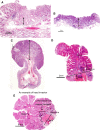Japanese Society for Cancer of the Colon and Rectum (JSCCR) guidelines 2016 for the treatment of colorectal cancer
- PMID: 28349281
- PMCID: PMC5809573
- DOI: 10.1007/s10147-017-1101-6
Japanese Society for Cancer of the Colon and Rectum (JSCCR) guidelines 2016 for the treatment of colorectal cancer
Abstract
Japanese mortality due to colorectal cancer is on the rise, surpassing 49,000 in 2015. Many new treatment methods have been developed during recent decades. The Japanese Society for Cancer of the Colon and Rectum Guidelines 2016 for the treatment of colorectal cancer (JSCCR Guidelines 2016) were prepared to show standard treatment strategies for colorectal cancer, to eliminate disparities among institutions in terms of treatment, to eliminate unnecessary treatment and insufficient treatment, and to deepen mutual understanding between health-care professionals and patients by making these Guidelines available to the general public. These Guidelines were prepared by consensus reached by the JSCCR Guideline Committee, based on a careful review of the evidence retrieved by literature searches, and in view of the medical health insurance system and actual clinical practice settings in Japan. Therefore, these Guidelines can be used as a tool for treating colorectal cancer in actual clinical practice settings. More specifically, they can be used as a guide to obtaining informed consent from patients and choosing the method of treatment for each patient. As a result of the discussions held by the Guideline Committee, controversial issues were selected as Clinical Questions, and recommendations were made. Each recommendation is accompanied by a classification of the evidence and a classification of recommendation categories based on the consensus reached by the Guideline Committee members. Here we present the English version of the JSCCR Guidelines 2016.
Keywords: Chemotherapy; Colorectal cancer; Endoscopy; Guideline; Radiotherapy; Surgery.
Conflict of interest statement
Funding
Preparation of these Guidelines was funded by the JSCCR. No financial support was received from any other organization or corporation.
Conflict of interest
The following corporations were disclosed by self-declaration of the Guideline Committee members and Guideline Evaluation Committee members.Asahi Kasei Medical Co., Ltd., Ajinomoto Pharmaceuticals Co., Ltd., AstraZeneca K.K., Astellas Pharma Inc., Eisai Co., Ltd., MSD K.K., Otsuka Pharmaceutical Co., Ltd., Ono pharmaceutical Co., Ltd., Olympus Corporation, JIMRO Co., Ltd., 3-D Matrix, Ltd., Yakult Honsha Co., Ltd., Quintiles Transnational Japan K.K., Glaxo-SmithKline K.K., Kyowa Hakko Kirin Co., Ltd., Sanofi Inc., Shionogi & Co., Ltd., Johnson & Johnson, ZERIA Pharmaceutical Co.,Ltd., Daiichi-Sankyo Company, Limited, Sumitomo Dainippon Pharma Co., Ltd., Taiho pharmaceutical Co., Ltd., Takeda Pharmaceutical Company Limited., Mitsubishi Tanabe Pharma Corporation, Chugai Pharmaceutical Co., Ltd., Toyama Chemical Co., Ltd., Eli Lilly Japan, Nihon Pharmaceutical Co., Ltd., Boehringer Ingelheim Japan, Novartis Pharma K.K., Pfizer Inc., Merck Serono Co., Ltd., Janssen Pharmaceutical K.K. Measures for the conflicts of interestThe Guideline Committee and the Guideline Evaluation Committee have been organized in members with a diverse range of disciplines, including surgery, internal medicine, radiology, pathology, etc., in order to minimize biased opinion. Each recommendation was determined not on an individual opinion basis but based on voting by the whole committee members, with consensus prioritized.
Figures















References
-
- Japanese Society for Cancer of the Colon and Rectum (2016) JSCCR Guidelines 2016 for the Treatment of Colorectal Cancer. Kanehara & Co.Ltd, Tokyo
-
- Fukui T, Yamaguchi N, Morizane T (2014) Minds handbook for clinical practice guideline development 2014. Igaku Shoin, Tokyo
-
- Aihara M, Mihara H, Murayama T (2010) GRADE system for clinical practice guideline—therapeutic intervention. Toppan Media, Hirosaki
-
- Guyatt GH, Oxman AD, Vist GE, et al. GRADE: an emerging consensus on rating quality of evidence and strength of recommendations. BMJ. 2008;336:924–926. doi: 10.1136/bmj.39489.470347.AD. - DOI - PMC - PubMed
Publication types
MeSH terms
LinkOut - more resources
Full Text Sources
Other Literature Sources
Medical
Research Materials

